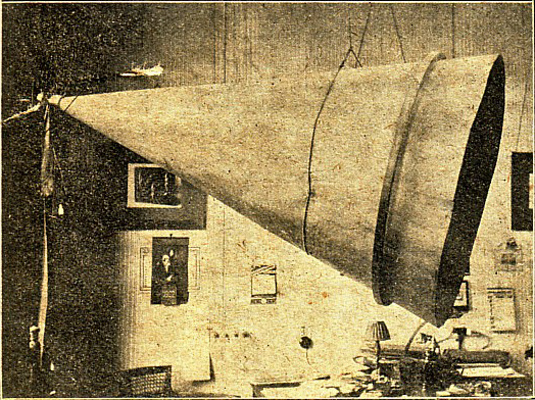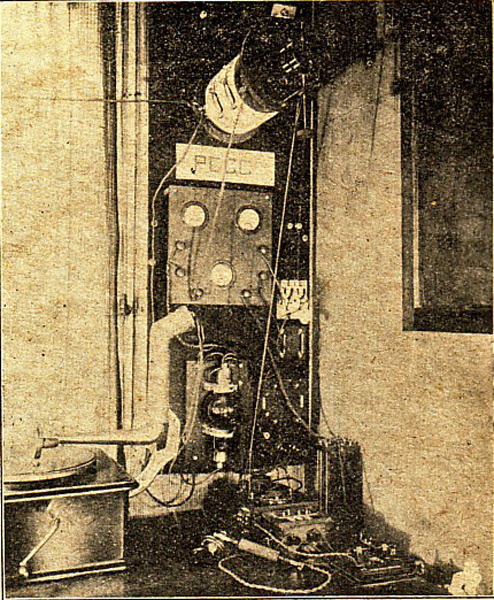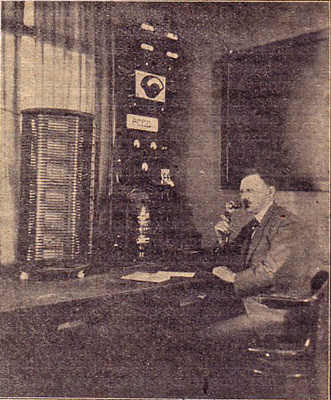|

The history of Dutch broadcasting, part IV
by Joh. Schnabel
Although the first broadcast using a telephone line, namely the one from Scala, was not exactly marvellous and did not receive a good press, the management of PCGG did everything in their power to come to a regular broadcasting of the well-known summer Kurhaus concerts. They succeeded and so we received the message that ''thanks to the full co-operation of the management of the company Zeebad Scheveningen, the agreement was made to wirelessly transmit the symphony and soloist concerts, which will be given in the Kurhaus in the summer of 1924, by the well-known radio telephony station PCGG.
To this end, the radio station in the Beukstraat will be connected to the Kurhaus by a direct cable of the municipal telephone service, in order to avoid possible interruptions, which occur frequently using normal telephone lines.
The great expenses will be partly paid by the Nederlandse Radio Industrie (PCGG) and the company Zeebad Scheveningen; some f 1500,- of expenses are not yet covered. With confidence, the voluntary contributions of the listeners are awaited''.
By the goodwill of ir. Idzerda, we are able to publish some photographs of the famous broadcasting station.

Big recording funnel made of multiplex cardboard with microphone at its end. The funnel was 3 metres long and had a diameter of 1 metre! This funnel was later replaced with a smaller model.
The picture above shows the monstrous funnel, which was mounted on the microphone (on the left). The diameter was 1 metre, the length no less than 3 metres!
Nowadays the microphone takes only a few decimetres of space. But... back then we didn't know any microphone amplifiers, so as much sound as possible had to work on the microphone, to get enough energy for the modulation.
The main part of the transmitter is shown below. On top the couple and aerial inductor, below that a small switchboard and at the bottom the Idzerda-Philips transmitter valve. At the front, a telegraphy key is visible at the right and the hand microphone in the middle. The well-known gramophone is placed at the left, connected to a second microphone by a rubber tube.

At the panel at the bottom the 100 watt transmitter valve; aerial-extension coil with grid coupling coil at the top
Below we include a picture of the telephony transmitter as it was in the years 1921 to '23. The coils of the above picture have disappeared to make place for the large aerial coil, made of copper foil, which we see on the left. With the microphone in his hand we see the owner of the station, ir. Idzerda, who besides being the company engineer was often also the announcer.

Idzerda at the microphone! At the left the aerial extension coil made of copper tape. At the right on the panel the transmitting valve, measurement equipment et cetera.
Ir. Idzerda is presently still in charge of the well-known factory in the Beukstraat in the Hague, where he constructs among other things receivers, which are known as technically and aesthetically excellent receivers.
We list some facts on PCGG below:
The first broadcasting station in Europe began as experimental station in February 1919 with experiments with undamped transmitters using three-electrode valves. Originally, little energy (10 to 20 watt) was used, while on the Royal Netherlands Industries Fair of 19 March 1919 the first demonstrations were given between the stands of the N.V. Ned. Radio-Industrie (presently N.V. Idzerda Radio) and the N.V. Philips' Gloeilampenfabrieken, both using radio telephony and radio telegraphy.
On 14 August 1919 the Minister of public works gave a license to Idzerda for reguarly transmitting music and speech with the radio station PCGG, after the request for this was filed on 7 February 1919.
On 22 August 1919, official experiments took place between PCGG and military stations, which were selected by the engineer of the Military Radio Service.
On 6 November 1919, Idzerda started to regularly broadcast radio concerts each Monday and Thursday evening, the programmes of which occurred as advertisements in one of the newspapers in the Hague.
Two important things came from these early experiments, namely the invention by Idzerda of a special modulation system and secondly, that from these practical experiments, the Philips light bulb factory learned how to make the transmitter valves according to advice of engineer Idzerda in consultation with the engineers Holst and Oosterhuis of Philips. The construction of grid and plate, the distance between them, the size of the gaps between the grid windings, the processing of a certain energy, the internal capacitance et cetera are all determined and calculated after many observations with PCGG.
Scans of the original pages can be found here. NB They are large picture files, approx 2 Mb.
Many thanks to Marcel Van De Gevel for submitting both the page scans and the English translation.
|